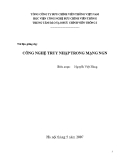Tài liệu Thư viện số
- Kỹ thuật cơ khí (1426 )
- Kỹ thuật xây dựng (1430 )
- Điện - Điện tử - Viễn thông (1681 )
- Công nghệ thông tin (1498 )
- CN Thực phẩm & Sinh học (1364 )
- Quản lý công nghiệp (940 )
- Khoa học cơ bản (1599 )
- Tài liệu tham khảo khác (621 )
Danh mục TaiLieu.VN
- Mẫu Slide Powerpoint
- Kinh Doanh Marketing (39320)
- Kinh Tế - Quản Lý (30571)
- Biểu Mẫu - Văn Bản (123435)
- Tài Chính - Ngân Hàng (23744)
- Công Nghệ Thông Tin (56521)
- Tiếng Anh - Ngoại Ngữ (9738)
- Kỹ Thuật - Công Nghệ (44193)
- Khoa Học Tự Nhiên (27343)
- Khoa Học Xã Hội (43227)
- Luật - Kinh tế luật (6560)
- Văn Hoá - Thể thao - Du Lịch (71283)
- Y - Dược - Sức Khoẻ (83234)
- Nông - Lâm - Thuỷ sản (16418)
- Luận Văn - Báo Cáo (217024)
- Tài Liệu Phổ Thông (244133)
- Trắc Nghiệm Online (213578)
- Trắc Nghiệm MBTI
- Trắc Nghiệm Holland
Antenna Technology
dipole antenna is a radio antenna that can be made of a simple wire, with a center-fed
driven element. It consists of two metal conductors of rod or wire, oriented parallel and
collinear with each other (in line with each other), with a small space between them. The
radio frequency voltage is applied to the antenna at the center, between the two
conductors. These antennas are the simplest practical antennas from a theoretical point of
view. They are used alone as antennas, notably in traditional "rabbit ears" television
antennas, and as the driven element in many other types of antennas, such as the Yagi.
Dipole antennas were invented by German physicist Heinrich Hertz around 1886 in his
pioneering experiments with radio waves.
driven element. It consists of two metal conductors of rod or wire, oriented parallel and
collinear with each other (in line with each other), with a small space between them. The
radio frequency voltage is applied to the antenna at the center, between the two
conductors. These antennas are the simplest practical antennas from a theoretical point of
view. They are used alone as antennas, notably in traditional "rabbit ears" television
antennas, and as the driven element in many other types of antennas, such as the Yagi.
Dipole antennas were invented by German physicist Heinrich Hertz around 1886 in his
pioneering experiments with radio waves.
Từ khóa: Antennas, wireless devices, practical engineering issues, antenna technology, engineering design, practical application
129 p tailieu_dhtcct 10/03/2013 445 4




